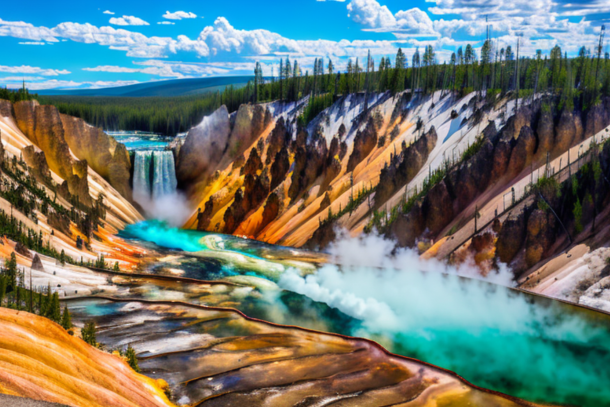Stargazing in Nature: Embarking on Cosmic Journeys Under Dark Skies

In the velvety canvas of the night sky, humanity has found solace, inspiration, and a profound connection to the cosmos. The act of stargazing, the simple act of tilting one's head upwards and losing oneself in the celestial expanse, is an enduring tradition that transcends cultures and epochs.
A Glimpse into the Cosmos' Tapestry
Throughout history, the stars above have served as guides for navigation, markers for time, and sources of wonder. They've ignited our imagination and kindled our curiosity about the universe beyond our planet's boundaries. From the constellations etched in mythologies to the scientific revelations unveiled through telescopic lenses, the night sky has woven itself into the fabric of our existence.
Nature Trails as Portals to Celestial Splendour
Nature trails, those winding pathways that immerse us in the tranquillity of the outdoors, often lead to something even grander – a vista unhindered by the glare of city lights. These trails carry us to dark sky areas, pockets of pristine celestial observation where stars twinkle with exceptional brilliance. It's in these sanctuaries of darkness that the allure of stargazing finds its zenith.
As the night falls and the air becomes a tapestry of whispers, these trails invite us to look up and explore. With each step, we journey not only through nature's embrace but also towards the mysteries of the universe itself.
Dark Sky Areas: Unveiling the Celestial Symphony
The night sky has been a canvas for human imagination and exploration since time immemorial. Dark sky areas, shielded from light pollution, have emerged as sanctuaries where the true brilliance of the cosmos comes alive.
The Essence of Dark Sky Areas
Dark sky areas are regions designated to preserve and protect the unblemished beauty of the night sky. These locales offer a gateway to celestial realms, where stars paint their constellations, planets glide gracefully, and the Milky Way spills its cosmic secrets. The absence of artificial light allows the universe's grandeur to shine unfettered, offering an experience that connects us with the awe-inspiring vastness of space.
Renowned Dark Sky Reserves
A constellation of celebrated dark sky reserves adorn our planet. From the Exmoor National Park in the UK to the Aoraki Mackenzie International Dark Sky Reserve in New Zealand, these pockets of pristine darkness invite stargazers to traverse through time and space. Each reserve boasts its unique attributes; some offer glimpses of rare astronomical phenomena, while others provide the canvas for mesmerising auroras.
Dark sky areas are more than just celestial observatories; they're sanctuaries for serenity, where the hushed whispers of the night sky impart wisdom that transcends our earthly existence.
The Stellar Dance: Astronomy Basics for Stargazing
As the sun sets and darkness unveils the celestial canvas, a captivating dance unfolds above. Amidst the expanse of the night sky lie constellations that have guided sailors and storytellers for centuries. In this section, we delve into the fundamental elements of this cosmic ballet.
Navigating the Celestial Map
Constellations are the storytellers of the night sky, forming intricate patterns that vary across cultures and seasons. These clusters of stars carry with them myths and legends that have been passed down through generations. Learning to recognise these patterns offers a profound connection to both history and the universe.
Stellar Personalities: Stars and Planets
Gazing upwards, you'll encounter stars of varying brilliance, each with its unique tale. From the mighty Orion's Belt to the steady glow of Polaris, these celestial beacons have guided explorers and wanderers throughout history. Additionally, keep an eye out for planets that often grace the sky with their presence, drawing attention with their steady light.
Celestial Events: The Cosmic Calendar
The night sky is a living calendar, dotted with astronomical events that unfold predictably. Witness the graceful dance of planets as they align, meteor showers that briefly light up the darkness, and the majestic lunar phases that mirror the ebb and flow of time. Understanding these events empowers stargazers to anticipate and partake in the wonders of the universe.
Observing the Unseen: Invisible Marvels
Beyond the stars visible to the naked eye lies a hidden universe. Telescopes unveil the secrets of distant galaxies, nebulae, and star clusters. These intricate celestial structures paint a picture of the cosmos on a grand scale, revealing the stunning intricacy of our universe.
As you stand beneath the night sky, let this knowledge be your guide. With each constellation, star, and event you discern, you're not just looking upwards; you're traversing through time and space, joining the grand cosmic dance that has captivated human curiosity for millennia.
Preparing for a Stargazing Adventure
A cosmic journey begins with the right tools and timing. As you embark on your stargazing adventure, here's how to set yourself up for an awe-inspiring experience.
Essential Gear for Stargazing
To unravel the mysteries of the night sky, a few key tools are essential companions. Telescopes open up the universe, magnifying celestial wonders that are otherwise distant smudges. Binoculars, while more portable, reveal stunning details of the moon's craters, star clusters, and even some of Jupiter's moons. Star charts, whether physical or digital, act as your cosmic roadmap, helping you navigate constellations and find specific objects.
Timing Your Cosmic Exploration
While the stars grace the night sky all year round, certain times offer heightened celestial spectacles. The optimal time for stargazing often coincides with the absence of the moon's bright light, allowing fainter stars and deep-sky objects to shine through. Understanding moon phases is key; during new moon phases, the moon is mostly invisible, providing a canvas for stars to truly sparkle. Special celestial events, such as meteor showers and planetary alignments, add extra doses of cosmic magic to your stargazing agenda.
Remember, every season brings its own celestial treasures, from the brilliant constellations of winter to the vibrant galaxies of summer.
The Art of Dark Adaptation
In the velvety embrace of the night, our eyes embark on a remarkable journey of adjustment. The art of dark adaptation is the key to unmasking the celestial splendour that often eludes our daytime perception.
Embracing the Night Vision Process
As you step away from artificial lights and into the embrace of nature's darkness, your eyes initiate the dark adaptation process. This involves the dilation of your pupils to capture more available light and the activation of rod cells in your retinas, which are more sensitive to dim illumination. With patience, the world around you transforms. Stars that once blended into the backdrop now twinkle with brilliance, and the contours of celestial bodies begin to emerge.
Minimising Light Pollution Interference
The celestial theatre presents its most vivid acts in the absence of urban glare. Minimising light pollution interference is essential for maximising your stargazing experience. Seek out remote spots away from city lights and allow yourself to be enveloped by the natural canvas of darkness. Shield your eyes from direct sources of light and consider using red-tinted lights, which have the least impact on your night vision.
The Dance of Adaptation and Appreciation
Dark adaptation is not merely a biological process; it's an art that involves patience, surrender, and a profound connection with the cosmos. As your eyes become attuned to the night, you'll find that the seemingly invisible unveils its mystique. Details once obscured come into view, constellations emerge from the obscurity, and a sense of interconnectedness with the universe blossoms.
So, allow the rhythms of your eyes' adaptation to synchronise with the rhythms of the cosmos. Let go of the need for instant illumination, and in doing so, you'll open a gateway to the wonders that lie above, awaiting your patient gaze.
Capturing the Cosmos: Astrophotography for Beginners
Astrophotography Unveiled
The night sky holds not only visual splendour but also the potential to capture its celestial tapestry through the lens of a camera. Astrophotography, often regarded as a complex art, is surprisingly accessible to beginners. It transforms the night sky into an ever-expanding canvas, where stars, galaxies, and nebulae become your subjects.
Essential Camera Settings
Embarking on your astrophotography journey requires knowing the basic camera settings that will elevate your cosmic captures. Begin with adjusting your camera to manual mode, enabling you to control every aspect of your shot. Choose the widest aperture your lens can offer; this helps gather as much light as possible. A lower aperture number (like f/2.8 or f/4) works well.
Tips for Capturing Celestial Wonders
-
Long Exposure: The key to capturing the brilliance of the night sky is long exposure. Use a shutter speed between 15 and 30 seconds, depending on your lens and the level of light pollution.
-
Stable Platform: To avoid blurriness, utilise a sturdy tripod to keep your camera steady during long exposures.
-
ISO Settings: Start with a lower ISO (around 800) and adjust as needed to avoid noise in your images.
-
Focus: Set your lens to manual focus and use the infinity symbol (∞) as your starting point. Fine-tune focus using live view or a bright star.
-
Remote Shutter Release: A remote shutter release minimises camera shake during exposures.
-
Experiment: Don't hesitate to experiment with different settings and compositions. Each shot is a learning experience.
-
Editing: Post-processing is a crucial step. Use software like Adobe Lightroom or Photoshop to enhance contrast, reduce noise, and bring out the brilliance of the stars.
Astrophotography beckons with its promise of unveiling the cosmos in ways the naked eye cannot fathom. Armed with the right knowledge and equipment, beginners can embark on a captivating journey of capturing the night sky's secrets.
Finding Your Perfect Stargazing Spot
As the sun dips below the horizon, a universe of stars unfolds above. To truly revel in this celestial splendour, it's crucial to find a location untouched by the glow of city lights. Here are essential tips for discovering the ideal stargazing spot:
Seeking Solitude Beyond Urban Glare
City lights can obscure the brilliance of the night sky, making it essential to venture away from urban areas. Aim for remote locations, such as national parks, rural areas, or hilltops, where light pollution is minimal.
Dark Sky Maps and Apps: Guiding the Way
In this digital age, stargazers have the advantage of utilising technology to locate prime celestial viewpoints. Dark sky maps and apps provide real-time light pollution data, helping you pinpoint areas with optimal conditions for stargazing. These tools allow you to plan your stargazing adventure with precision.
Weather Considerations: Cloud Cover and Clarity
Beyond light pollution, the clarity of the night sky hinges on weather conditions. Clear skies are ideal for stargazing, so it's wise to keep an eye on weather forecasts before embarking on your journey. Cloud cover can greatly affect your visibility, so choosing a night with minimal cloud interference is paramount.
Safety and Accessibility: Choosing Wisely
While seeking remote spots, ensure your chosen location is accessible and safe. Take note of local regulations, park opening hours, and any potential hazards. It's advisable to inform someone about your stargazing plans and estimated return time, particularly if you're heading to more isolated areas.
Nature's Harmony: Embracing the Night
Select spots that offer a blend of tranquillity and celestial beauty. A lakeside, a quiet meadow, or a gentle hilltop can provide a serene environment for your cosmic exploration.
By combining these considerations with digital tools, you'll discover locations where the night sky unveils its grandeur without hindrance. Whether you're capturing the Milky Way's brilliance or gazing at distant constellations, your perfect stargazing spot awaits in the heart of nature.
Stargazing Etiquette: Respecting the Nocturnal Ecosystem
In the embrace of the night sky, an unspoken pact is formed between humans and the cosmos. It's not just about marvelling at the stars; it's also about treading lightly on the very earth that supports us and the delicate nocturnal ecosystem that thrives in the shadows.
Minimising Human Impact
As you venture into the darkness to gaze upon the celestial ballet, remember that your presence has an impact. Minimising your intrusion means treading softly, refraining from disturbing plants and wildlife that call these nocturnal realms their home. Avoid trampling on delicate flora, and if a path exists, stay on it to minimise soil compaction and preserve the ecosystem.
Preserving the Silence of the Night
The night holds a symphony of its own—crickets chirping, owls hooting, and the rustling of nocturnal creatures. The hushed conversation of the cosmos is punctuated by these natural melodies. It's a sacred silence that allows us to hear the universe's whispers. As you gaze upwards, remember to honour this silence by speaking softly or, ideally, refraining from speaking at all.
Dark Sky Areas: Jewels to Protect
Dark sky areas are sanctuaries for both humans and nature. These pockets of darkness allow us to peer into the universe's depths while offering refuge to countless species that thrive in these dimly lit spaces. By adhering to stargazing etiquette, you become a guardian of these spaces, ensuring their preservation for generations to come.
Safeguarding the Future of Stargazing
Ultimately, the magic of stargazing lies in its continuity. By respecting the nocturnal ecosystem, we ensure that future generations can also experience the wonder of gazing upon the cosmos in its unfiltered brilliance. As you contemplate the stars, let your reverence extend to the ground beneath your feet and the world around you.
Awe-Inspiring Night Sky Sightings
Rare Celestial Events: Glimpses into the Cosmic Calendar
In the grand theatre of the night sky, certain celestial events stand as star-studded spectacles that captivate even seasoned astronomers. From the graceful dance of planets aligning to the mesmerising transits of Mercury and Venus, these infrequent occurrences offer us a glimpse into the intricate workings of our solar system.
Shooting Stars and Meteor Showers: Cosmic Fireworks
Meteor showers, like celestial fireworks, paint the sky with streaks of light as Earth passes through the debris trails left by comets. Perseids, Geminids, and Leonids grace the heavens, dazzling us with their radiant displays. To witness this celestial ballet, all that's required is a dark, open sky and a sense of wonder.
Eclipses: The Enthralling Celestial Ballet
Eclipses, the cosmic choreography where celestial bodies align to create breathtaking moments of darkness and light, hold a universal fascination. Solar eclipses transform the day into an eerie twilight, while lunar eclipses bathe the moon in a rusty hue. To experience these enchanting phenomena, planning and patience are essential.
Strategies for Celestial Observation
To truly savour these celestial wonders, a touch of strategy goes a long way. Keep an eye on astronomy calendars to anticipate upcoming events. Scout out optimal locations for clear views and minimal light pollution. Equip yourself with knowledge about each phenomenon to fully appreciate the cosmic theatre unfolding above.
Capturing the Cosmos: Astrophotography in the Night Sky
Astrophotography offers a remarkable way to immortalise these rare occurrences. With basic equipment and a bit of practice, you can capture the shimmering trails of meteors or the momentary unity of celestial bodies during an eclipse. The results can be both visually stunning and personally rewarding.
Conclusion
As the world sleeps and the stars awaken, nature's theatre unfurls above, revealing an expanse of wonder that has captivated humanity since time immemorial. Stargazing, far from being a mere pastime, is an odyssey into the cosmos, an exploration that brings us closer to the very essence of the universe.
Cosmic Poetry in Darkness
In the tranquil embrace of nature's darkness, where city lights retreat, the celestial tapestry unveils itself. Each star is a poem, a twinkle in the eyes of eternity, and every constellation a story woven into the night sky. The profound beauty of the cosmos connects us to the mysteries beyond, sparking awe and introspection.
Your Cosmic Voyage Awaits
To the readers who seek to embark on their own cosmic journeys, the invitation is clear. Venture into the heart of dark sky areas, let your gaze transcend earthly concerns, and lose yourself in the constellations. Witness the meteor showers that paint the sky with fleeting brilliance and the planets that dance to an age-old rhythm.
In a world often dictated by haste, technology, and urban lights, stargazing gifts us a chance to reconnect with the celestial realm. It offers solace, perspective, and the humbling realisation that we are but tiny specks in the grand tapestry of the cosmos.
So, as night falls and the stars emerge, take a moment to step away from the ordinary and embrace the extraordinary. Allow the beauty of the night sky to kindle your curiosity, to deepen your appreciation for the vastness of existence, and to ignite the spark of wonder that resides within us all.
Related to this article are the following:
I do hope you have enjoyed this article and hope that you will subscribe to my newsletter so you can get the latest information about all things naturally relaxing.
Stay in touch, join the Naturally Relaxing Newsletter
Newsletter Signup
Post Your Comments
or post as a guest
Be the first to comment.
Latest articles in Nature

Exploring the UK’s Most Serene Coastal Trails

The Healing Power of Nature: Forest Bathing Explained

Sustainable Gardening: Tips for Growing Your Own Herbs

The Yellowstone Supervolcano: A Sleeping Giant

The Lost City of Atlantis: A Geological Mystery






